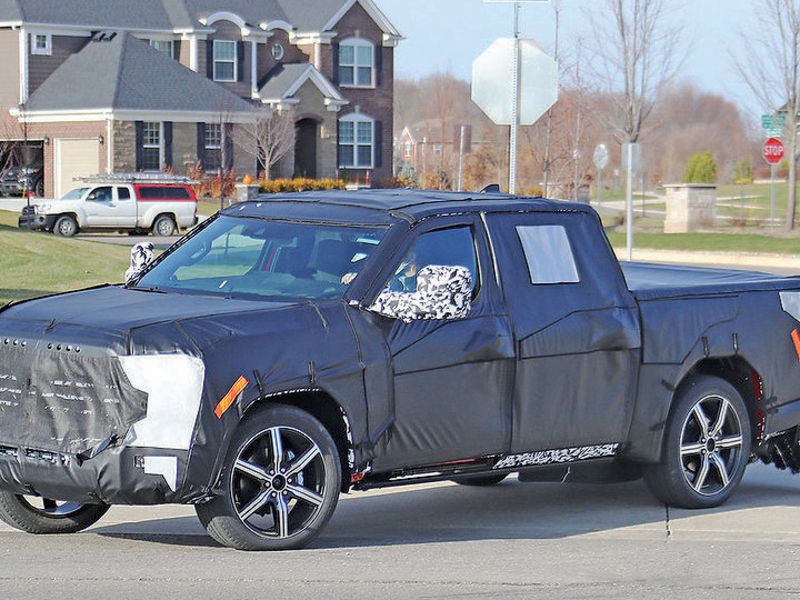
Toyota dealers this week will get their first concrete details about the brand’s plans for its 2022 Tundra full-size pickup — the truck’s first redesign in 14 years — which is set to arrive in dealerships by the end of the year.
But beyond a teaser video shown to dealers in November that revealed its LED lighting and what’s been gleaned from test mules in various locations, very few details about the Tundra have leaked out. And executives at Toyota Motor North America have been characteristically tight-lipped.
Toyota’s make meeting at the first virtual NADA Show this week will also cover the brand’s newly improved SmartPath digital retailing tool. But the brand’s retailers are particularly piqued by the prospect of having a competitive full-size pickup for the first time in years and the prospect of stealing market share in the segment from the Detroit 3.
“The new Tundra is the most exciting thing we’ve had in the last five-plus years,” said Robby Findlay, chairman of the Toyota National Dealer Advisory Council. “I mean, we’ve been waiting so long for a new Tundra; we know the potential of that full-size-truck market. And from everything that they’re telling us, we’re going to have best in class. I mean, we’re going to have a world beater, and it’s going to be fun to really go toe-to-toe with the domestic trucks.”
The excitement is understandable. The current Tundra is so old and such an afterthought among pickup buyers that in January, Toyota’s full-size pickup was outsold by the Sienna, Toyota’s minivan. Compare that with the Ram pickup, which last year outsold the Chrysler Pacifica 6-to-1.
Production of the 2022 Tundra is expected to begin in late fall at Toyota’s pickup assembly plant in San Antonio, after an on-the-fly retool to accommodate the new platform without slowing production of the hot-selling Tacoma and existing Tundra.
Here’s what is known about the 2022 Tundra:
- It is the lead vehicle for Toyota’s new global body-on-frame platform, which eventually will underpin the rest of the brand’s non-unibody U.S. lineup, with the Sequoia to follow in 2022, and the 4Runner and Tacoma to follow in 2023.
- The 2021 model’s 5.7-liter V-8 and six-speed automatic transmission will be replaced by a turbocharged V-6 and at least an eight-speed automatic transmission, aided by an optional hybrid power pack tuned specifically to boost torque and power, in addition to helping fuel economy.
- Details of the Tundra’s suspension have been hidden on test mules, so it’s unclear whether it will keep its live axles front and rear. What is clear is a switch to six-lug wheels, which indicate that the redesigned Tundra’s maximum tow rating will be higher than the current model’s 10,200 pounds, as will its maximum payload of 1,730 pounds.
- In terms of driver assistance and infotainment, brand executives have committed that all of their vehicles would come standard with the latest Toyota Safety Sense system. That will mean the addition of several sensors and cameras over the existing model for things such as lane keeping, blind-spot monitoring, adaptive cruise control and other functions. To keep pace with others in the segment, the new Tundra also is likely to feature Toyota’s latest infotainment system.
- The teaser video shown to dealers in November and subsequently leaked revealed front and rear LED lighting, including new stylized accent lights over the headlamps as well as on the tailgate. Test mules also show retractable side steps and an oversized sunroof, though it’s unclear whether the features would be standard across all models.
While Toyota executives have said little about the new Tundra, they have acknowledged that the pickup is in need of an update. They have committed publicly to the hybrid powertrain and explained that it would be tuned to add power and torque.
The Tundra has been showing its age for a while.
Last year, with 109,203 total sales in the U.S., it once again placed fifth out of six full-size pickups in its segment, beating only the Nissan Titan. In fact, since it went on sale in the U.S. in 1999, the Tundra has never bested the annual sales of any full-size pickup from the Detroit 3.
The Tundra’s current generation dates from 2007 — a 14-year life cycle that is the pickup equivalent of a Galapagos tortoise compared with the five-year turn of its domestic rivals. And at 13 mpg city/17 mpg highway, the fuel economy of the 2021 Tundra lags every competitor in the full-size segment.
Karl Brauer, a longtime industry analyst who now is executive publisher at CarExpert.com, said Toyota’s experience developing the current-generation Tundra was “unfortunate,” because the automaker’s decision to upsize the not-quite-full-size Tundra to take on domestic trucks in 2007 was expensive and ill-timed.
Rising fuel prices and then a global economic collapse just as the truck was launching took a heavy toll on Toyota’s aspirations in the segment, as did the cost and construction time to get the San Antonio plant up and running.
“I think Toyota felt highly burned by the whole thing,” Brauer said. “That’s not the Toyota way, to suffer financially on a new product.” Toyota opted to do only a partial update of the Tundra in 2014, causing the Tundra to fall further behind its domestic competitors in technology.
“I think they’re in a terrible position now, but they’re committed,” Brauer said.
With the redesign, one thing is clear: The cost of the Tundra is likely to rise over that of the current model, Findlay said.
“I don’t think we realize that with all the new bells and whistles and powertrain, we’re going to be in a different payment range, and so we may lose some of those loyal Tundra customers,” the dealer council chairman said. “But I’m still excited at what Toyota is going to offer out there. It’s going to be unbelievable.”